Band Organs
Euclid Beach had Four Great Organs Including the Four-Ton Gavioli
The Rich History Of The Euclid Beach Amusement Park Organs
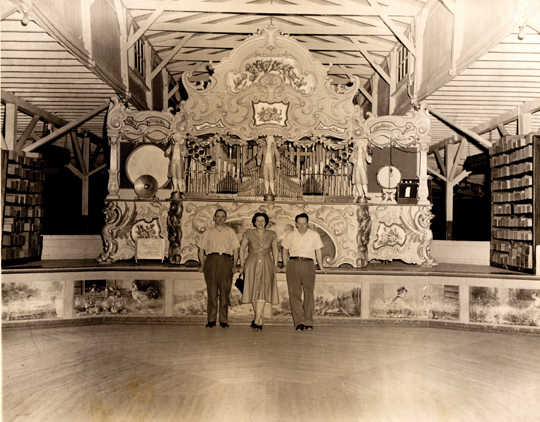
Gavioli Photo Used with Permission, Copyright: Trager Archives
The Euclid Beach Gavioli remains the only surviving 110 key Gavioli in its complete factory built format. The Gavioli still in beautiful original condition is now in the Trager Collection in Illinois where it awaits restoration.
By Howard Kast
With article revisions courtesy of Tim Trager

Reprinted courtesy of The Carousel News & Trader
Euclid Beach was located on the shores of Lake Erie In Cleveland, OH. The park was a walk-in park (no admission) and one of the finest amusement parks in Ohio. It was located on 72-acres that had lots of shade trees, benches and pavilions so families could bring picnics to enjoy the sights, sounds and wonderful rides.
The Humphrey family that owned the park made sure the park was always family-oriented by not allowing alcoholic beverages or games of chance, which stayed in effect until the park’s closing on Sept. 29, 1969.
The park had four band organs. There was the Style A Artizan 46 keyless Band Organ (shown right), which was the first organ you would hear when entering the park from the parking lot. It was located under the platform of the Rocket Ships that was near the lake. People riding the Rocket Ships had the best of three worlds, listening to the Artizan organ, cooling off on those hot days of summer, and the view of the lake as the three rocket ships soared 50-feet in the air as they whirled around the 101’ 5” tower. The Artizan was purchased after the park closed in 1969 by a gentleman who played it for friends until he passed away. It was stored in a garage until just recently when it was purchased by the present owner who has lots of memorabilia from Euclid Beach. It is currently being restored so it will once again play the sounds people enjoyed in the hey-day of the park.
Photo courtesy of Howard Kast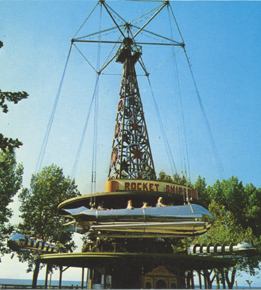
You can just see the top of the Artizan organ under the ride at the bottom of the picture.
The Artizan was manufactured by the Artizan Factories, Inc. of North Tonawanda, NY. Artizans were well made and were highly regarded for their good musical arrangements and finely voiced pipes. This company, which operated during the 1920s, was essentially a regrouping of the former employees of the North Tonawanda Musical Instrument Works under the guidance of the Christian Maerten.
Maerten was an innovative designer of band organ mechanisms and designed the pressure pneumatic system which the Artizan organs used. The organs were less mechanically complicated than the vacuum system organs, which required a large vacuum bellows. The pressure system dispensed with the periodic need to clean the tracker bar screen, which was not needed. See the above patent view.

Photo Used with Permission, Copyright: Trager Archives.
North Tonawanda Musical Instrument Works 87 keyless Band Organ
The second band organ you would hear was located on the wonderful Euclid Beach Carrousel, which was near the center of the park. PTC #19 is a magnificent 54-horse machine with four rows of horses including full-size horses on the outside row. The carousel operated on a 90-foot diameter platform while at Euclid Beach. PTC #19 was installed in 1910 and had an 87 keyless North Tonawanda band organ that had an unusual sound for a 87 key instrument because, for the 10 years I worked at the park, they used the rolls from the 46 keyless Artizan. I do not ever remember hearing the organ play the 82 key music. I am not a band organ expert and am not sure if they were able to use the tracking bar on the North Tonawanda instrument to play the Artizen style “A” rolls of music which is the music the organ was intended to play. I worked on the Rocket Ships and would hear the same music from the Artizen on the North Tonawanda organ.

The original facade of the Euclid Beach Carrousel organ.
The North Tonawanda organ was sold when the park closed in 1969. It was purchased by Alex Jordan for his House on the Rock attraction. It was never used in the attraction and later sold to John Daniels of California. The instrument was completely rebuilt by Mike Argain and remained there until, I believe, 2005 or 2006 when a Vince Aveni from northeast Ohio acquired it for his extensive collection of musical instruments.
Aveni had the instrument completely gone over and voiced for his music room. I was honored to be one of the first to hear the magnificent sounds of the fully restored 87 keyless North Tonawanda organ. The instrument has 293 pipes, bass drum, snare drum, and cymbal. When Aveni turned it on, the sound was magnificent. I realized then that I had never heard the real organ and told my friend with a smile it could not be the same instrument I heard for all those years. The only thing I can say is the public really missed out on the wonderful sounds that organ could have been giving the riders of the magnificent Euclid Beach Carrousel for all those years. The North Tonawanda band organ is truly one of the finest sounding instruments I have every heard. The picture below is what it looks like today.
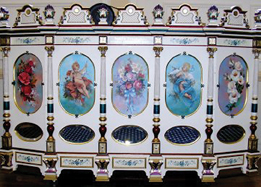
The restored facade of the Euclid Beach organ today.
Euclid Beach also had another 87 keyless North Tonawanda Band Organ that was on the Flying Pony ride which was erected for the summer of 1903 and the new band organ was added in 1909. After the Flying Pony ride was sold, this North Tonawanda Organ went into storage, and then passed through the hands of several owners. The organ was eventually restored by John Hovancak for the Place de la Musique Collection (www.placedelamusique.org) in Barrington Hills, IL.
The North Tonawanda Musical Instrument Works incorporated in 1906. It was comprised of many of Eugene DeKleist’s top employees, including Frank Morganti, who came with DeKleist from England, and Henry Tussing, the noted music arranger and leader of the North Tonawanda band. Euclid Beach Park was a prime customer having early on purchased two large organs including a Style 1316 “Grand Military Band Organ” for the skating rink. An early North Tonawanda Musical Instrument Works catalog featured a glowing testimonial from Euclid Beach Park. Later these organs were replaced by the Gavioli and the two 87 keyless North Tonawandas were purchased by the park. The 87 keyless roll was the spooled version of the earlier 82 keyless endless roll. The rolls were very well arranged for this scale.
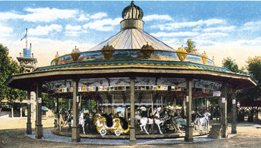
Euclid Beach PTC #19 Carrousel
110 Key Gavioli Concert Organ
As you walk to the far end of the park you start hearing the wonderful sounds of the King of Organs which was located in the roller skating rink. The magnificent Gavioli had 110 keys and was said to have been built to replicate a 120 piece orchestra (Figure 3). It was 13 feet high and 18 feet long and weighs about 4 tons. The music was produced by books of music rather than rolls like the Artizan and North Tonawanda instruments and the book music weighed up to twenty five pounds each. The books were made of a very heavy type card board with holes in them that produced the music. The Gavioli style Militaire Extra-Powerful has over 1000 pipes and produced extensive ensembles of registrations such as violins, saxophones, Piccolos, basses and contra basses, Baritone, Brass Trumpets, Brass Trombones, Clarinets and percussion which included a Bass Drum, snare drum, cymbal, Castanets, and repeating tubular bells. On top of the organ facing the rear is a brass trumpet, clarinet, and piccolo fanfare section with its own windchest and facade. The instrument was powered by a 3 HP motor and developed 10 inches of wind pressure, the key frame is operated by a 1/4 HP electric motor via a variable speed flat belt drive allowing changes in tempo.
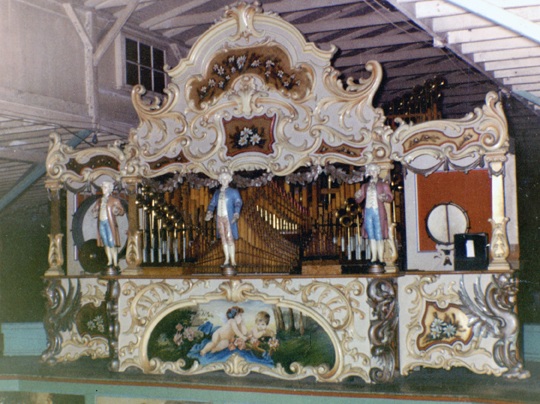
Photo Used with Permission, Copyright: Trager Archives
The Gavioli organ at the Euclid Beach skating rink. The rink was 200 feet by 100 feet with shutters that opened up to the outside.
Gavioli et Cie of Paris was the most famous and most prolific builder of band organs in Europe. The 110 and 112 key organs were the top-of-the-line organs of the firm. The Euclid Beach Gavioli was imported through the Bond Street office of Gavioli through its agent, Louis Berni. The Euclid Beach Gavioli was one of the largest band organs ever sold into the United States during the hey-day. Initially the Gavioli was used on the bandstand of the huge Lenox Lyceum Skating Rink located just south of Central Park in New York City. A surviving postcard addressed to Mr. Gavioli shows the organ in this location. The Gavioli was later sold by Louis Berni to the Humphreys for $15,000.00. This price was higher than the $10,000.00 paid for the carousel! The organ was installed in the skating rink in 1910 after a very short stay at the Humphrey owned Elysium Ice skating rink. The organ did not go over very well at the Elysium and was moved to Euclid Beach Roller Rink and was a huge success. The music was played at a slower tempo than written to keep the skaters from going to fast, it played there until 1962 when the Skating rink was closed and an Antique Car ride was installed in the rink. The organ played only occasionally when the ride was operating but then it went silent and remained in the rink (ride) until it was sold shortly thereafter.
The Humphrey family was very proud of the Gavioli. To many vistors it was the musical soul of the park. Over the years the Humphreys purchased a large library of music comprising hundreds of books for it featuring overtures, concert waltzes, marches, popular waltzes and fox trots. Music continued to be purchased well into the 1950's. Its large chromatic scale with broad ranges of orchestral pipework allowed it to play music transcribed from a concert band score without compromise. The English seller of Gavioli organs, Chiappa called the 110 key Gavioli, "Mr. Gavioli's Masterpiece"! The Euclid Beach Gavioli remains the only surviving 110 key Gavioli in its complete factory built format. The Gavioli still in beautiful original condition is now in the Trager Collection in Illinois where it awaits restoration.
This article originally appeared in The Carousel News & Trader, October 2008, Vol. 14, No. 10. Reprinted courtesy of the CN&T and with the permission of contributing authors, Howard Kast and Tim Trager.